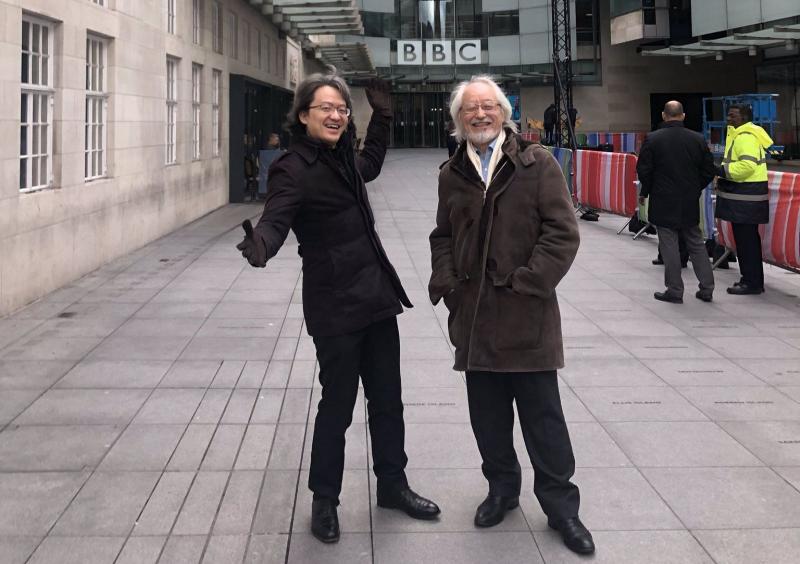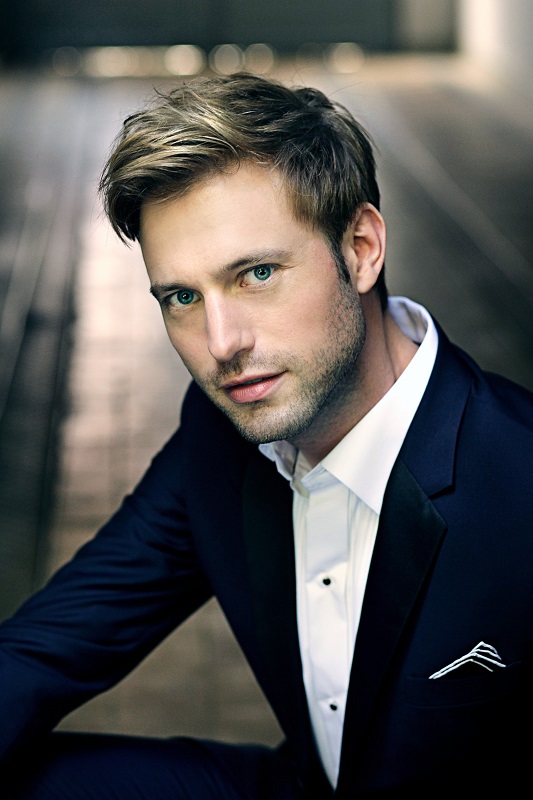Bach Sunday with the Suzukis, RAM / Appl, AAM, Milton Court review - father, son and Holy Ghost | reviews, news & interviews
Bach Sunday with the Suzukis, RAM / Appl, AAM, Milton Court review - father, son and Holy Ghost
Bach Sunday with the Suzukis, RAM / Appl, AAM, Milton Court review - father, son and Holy Ghost
From the grandest beginnings of the B Minor Mass at lunchtime to solo cantatas at night

Not long after noon on Sunday, strange bells began ringing. In just 11 bars, Bach summons pairs of flutes, oboes and violas da gamba against pizzicato strings and continuo to tintinnabulate against the alto's recitative lines about a "vibrating clang" to "pierce our marrows and our veins". These hallucinatory sounds and harmonies could have been composed yesterday.
That you can find such moments of sheer astonishment in just about every Bach cantata - there is another towards the end of "Laß, Fürstin, laß noch einen Strahl" ("Let, Princess, just one more glance") when the choir breaks into unison, buoyantly highlighted by Masaaki Suzuki - means a lifetime may not be enough to catch live performances of them all. So opportunities like the Royal Academy of Music's Sunday series - if you can get a ticket, for they're like gold dust and seem to be all snapped up by senior patrons - and the Barbican's Bach: A Beautiful Mind weekend are to be treasured.
Though not linked series-wise, the two Sunday events gave us a serendipitous chance to hear Suzuki senior - one of the great JSB doyens of our time for performances with his pioneering Bach Collegium Japan - working, as he often does, with music students (★★★★) and later his gifted son Masato conducting and playing alongside the Academy of Ancient Music, trying - and often succeeding - to bring to life the dead zone of Milton Court (★★★).
 The other shock of the lunchtime concert was that I hadn't checked to see which mass was keeping the funeral cantata company, and was so jolted to hear the B minor Kyrie seizing our attention with the great blaze of its opening bars. Here was the first third of the greatest mass-setting ever, composed during a period of mourning for another ruler, Augustus II 'the Strong", to secure a post at the Saxon court in Dresden under the next Highness in 1733 (Bach eventually got there three years later, and only completed what we know as the B minor Mass towards the very end of his life). The shock and awe suggest that the composer had the whole edifice in mind from the start, but it's already enough to witness the three contrasting parts of the Kyrie and the breathtakingly varies sequence of the Gloria.
The other shock of the lunchtime concert was that I hadn't checked to see which mass was keeping the funeral cantata company, and was so jolted to hear the B minor Kyrie seizing our attention with the great blaze of its opening bars. Here was the first third of the greatest mass-setting ever, composed during a period of mourning for another ruler, Augustus II 'the Strong", to secure a post at the Saxon court in Dresden under the next Highness in 1733 (Bach eventually got there three years later, and only completed what we know as the B minor Mass towards the very end of his life). The shock and awe suggest that the composer had the whole edifice in mind from the start, but it's already enough to witness the three contrasting parts of the Kyrie and the breathtakingly varies sequence of the Gloria.
Suzuki senior had forged a vibrant entity from the 17 singers of the Academy Bach Consort, much more responsive to the meanings of German and Latin texts than many another small-scale choir in the UK, and underpinned crucially by three resonant basses. Solo-wise, there was more of a challenge - you realise with these young singers how much Bach demands in terms of range and a length of line which taxes the breath control - and here an alertness to the text countered a chrysalis sense of vocal personality. The big exception came, thrillingly, just before the trumpet-crowned panoply of the final "Cum Sancto Spiritu", in the bass aria "Quoniam tu solus sanctus". Not only was there a sheen to the intelligence of Johannes Moore, but also the most perfect delivery I've ever heard live of the treacherous horn solo from Isaac Shieh (pictured above in the RAM's Duke's Hall with Masaaki Suzuki). It might seem invidious to talk of stars when this is all about ensemble, but Shieh truly crowned the whole achievement.
 Moore's ideal sound was not to be replicated by baritone Benjamin Appl (pictured left by Uwe Arens/Sony Classical) in the evening concert - awkward, because the programme, which I believe Masato Suzuki came to at a relatively late stage, shone the spotlight on its singer. Appl was certainly more comfortable in the lively cantata of the second half, "Ich will den Kreutzstab gerne tragen" ("I shall willingly carry the cross") than being out of his depth, in both senses, for the great "Ich habe genug" ("I am content"), the low notes almost invisible, the overall tone not warm enough - at least in Milton Court's dry acoustics - for the deep sympathy this masterpiece must elicit.
Moore's ideal sound was not to be replicated by baritone Benjamin Appl (pictured left by Uwe Arens/Sony Classical) in the evening concert - awkward, because the programme, which I believe Masato Suzuki came to at a relatively late stage, shone the spotlight on its singer. Appl was certainly more comfortable in the lively cantata of the second half, "Ich will den Kreutzstab gerne tragen" ("I shall willingly carry the cross") than being out of his depth, in both senses, for the great "Ich habe genug" ("I am content"), the low notes almost invisible, the overall tone not warm enough - at least in Milton Court's dry acoustics - for the deep sympathy this masterpiece must elicit.
Appl was disappointing, too, in the poignant glory of "Es ist vollbracht"("It is finished") - not the famous setting of those words in the Matthew Passion, but an equally profound and original treatment in the cantata "Sehet, wir gehn hinauf gen Jerusalem" ("Behold, let us go up to Jerusalem") - diminished by the voice at the same time as it pierced the soul in the contribution of the orchestra and the playing of oboist Leo Duarte.
It wasn't just Duarte who shone, in the first-half cantata sinfonias, but also Suzuki the younger in a surprising manifestation of what we know best as the outer movements of the D minor Harpsichord Concerto. As sinfonias for two more cantatas, they sounded startlingly different in the collaboration between the players and the conductor at the chamber organ, a virtuosic tour de force which twice stole the show.
Explore topics
Share this article
The future of Arts Journalism
You can stop theartsdesk.com closing!
We urgently need financing to survive. Our fundraising drive has thus far raised £49,000 but we need to reach £100,000 or we will be forced to close. Please contribute here: https://gofund.me/c3f6033d
And if you can forward this information to anyone who might assist, we’d be grateful.

Subscribe to theartsdesk.com
Thank you for continuing to read our work on theartsdesk.com. For unlimited access to every article in its entirety, including our archive of more than 15,000 pieces, we're asking for £5 per month or £40 per year. We feel it's a very good deal, and hope you do too.
To take a subscription now simply click here.
And if you're looking for that extra gift for a friend or family member, why not treat them to a theartsdesk.com gift subscription?
more Classical music
 From Historical to Hip-Hop, Classically Black Music Festival, Kings Place review - a cluster of impressive stars for the future
From quasi-Mozartian elegance to the gritty humour of a kitchen inspection
From Historical to Hip-Hop, Classically Black Music Festival, Kings Place review - a cluster of impressive stars for the future
From quasi-Mozartian elegance to the gritty humour of a kitchen inspection
 Shibe, LSO, Adès, Barbican review - gaudy and glorious new music alongside serene Sibelius
Adès’s passion makes persuasive case for the music he loves, both new and old
Shibe, LSO, Adès, Barbican review - gaudy and glorious new music alongside serene Sibelius
Adès’s passion makes persuasive case for the music he loves, both new and old
 Anja Mittermüller, Richard Fu, Wigmore Hall review - a glorious hall debut
The Austrian mezzo shines - at the age of 22
Anja Mittermüller, Richard Fu, Wigmore Hall review - a glorious hall debut
The Austrian mezzo shines - at the age of 22
 First Person: clarinettist Oliver Pashley on the new horizons of The Hermes Experiment's latest album
Compositions by members of this unusual quartet feature for the first time
First Person: clarinettist Oliver Pashley on the new horizons of The Hermes Experiment's latest album
Compositions by members of this unusual quartet feature for the first time
 Gesualdo Passione, Les Arts Florissants, Amala Dior Company, Barbican review - inspired collaboration excavates the music's humanity
At times it was like watching an anarchic religious procession
Gesualdo Passione, Les Arts Florissants, Amala Dior Company, Barbican review - inspired collaboration excavates the music's humanity
At times it was like watching an anarchic religious procession
 Classical CDs: Camels, concrete and cabaret
An influential American composer's 90th birthday box, plus British piano concertos and a father-and-son duo
Classical CDs: Camels, concrete and cabaret
An influential American composer's 90th birthday box, plus British piano concertos and a father-and-son duo
 Cockerham, Manchester Camerata, Sheen, Martin Harris Centre, Manchester review - re-enacting the dawn of modernism
Two UK premieres added to three miniatures from a seminal event of January 1914
Cockerham, Manchester Camerata, Sheen, Martin Harris Centre, Manchester review - re-enacting the dawn of modernism
Two UK premieres added to three miniatures from a seminal event of January 1914
 Kempf, Brno Philharmonic, Davies, Bridgewater Hall, Manchester review - European tradition meets American jazz
Bouncing Czechs enjoy their Gershwin and Brubeck alongside Janáček and Dvořák
Kempf, Brno Philharmonic, Davies, Bridgewater Hall, Manchester review - European tradition meets American jazz
Bouncing Czechs enjoy their Gershwin and Brubeck alongside Janáček and Dvořák
 Solomon, OAE, Butt, QEH review - daft Biblical whitewashing with great choruses
Even a top soprano and mezzo can’t make this Handel paean wholly convincing
Solomon, OAE, Butt, QEH review - daft Biblical whitewashing with great choruses
Even a top soprano and mezzo can’t make this Handel paean wholly convincing
 Two-Piano Gala, Kings Place review - shining constellations
London Piano Festival curators and illustrious friends entertain and enlighten
Two-Piano Gala, Kings Place review - shining constellations
London Piano Festival curators and illustrious friends entertain and enlighten
 Echo Vocal Ensemble, Latto, Union Chapel review - eclectic choral programme garlanded with dance
Beautiful singing at the heart of an imaginative and stylistically varied concert
Echo Vocal Ensemble, Latto, Union Chapel review - eclectic choral programme garlanded with dance
Beautiful singing at the heart of an imaginative and stylistically varied concert
 Scott, Irish Baroque Orchestra, Whelan, RIAM, Dublin review - towards a Mozart masterpiece
Characteristic joy and enlightenment from this team, but a valveless horn brings problems
Scott, Irish Baroque Orchestra, Whelan, RIAM, Dublin review - towards a Mozart masterpiece
Characteristic joy and enlightenment from this team, but a valveless horn brings problems

Add comment